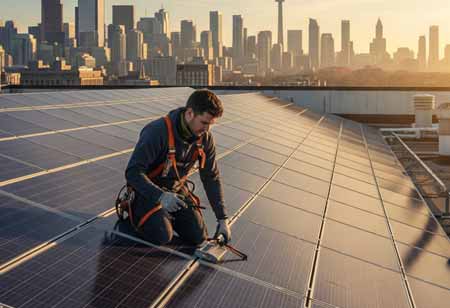Thank you for Subscribing to Energy Business Review Weekly Brief
The Role of O&M in Canada's Energy Transition
Canada's solar industry is evolving to prioritize long-term asset maintenance through O&M-as-a-Service, ensuring optimal performance, enhanced profitability, and reliable energy generation over the long term.

By
Energy Business Review | Tuesday, August 12, 2025
Stay ahead of the industry with exclusive feature stories on the top companies, expert insights and the latest news delivered straight to your inbox. Subscribe today.
The Canadian solar industry is transitioning from an initial phase of rapid installation to a more mature stage, prioritizing long-term performance and asset optimization. As the nation's solar installation portfolio grows, encompassing everything from extensive utility-scale farms to commercial rooftop systems, a specialized business model is gaining considerable momentum: Operations and Maintenance-as-a-Service (O&M-as-a-Service). This model signifies a fundamental shift, reclassifying the maintenance of solar assets from a secondary consideration to a sophisticated, data-driven service essential for maximizing energy production and guaranteeing financial returns throughout a solar project's 25-plus-year operational life.
Drivers of Growth in the Canadian Market
The maturation of the global solar market primarily drives the escalating demand for solar panel services. As the solar industry has grown and expanded, a significant number of early installations, particularly those from a decade or more ago, are now reaching a critical juncture. These systems are moving beyond their initial warranty periods, which typically cover manufacturing defects and basic performance, and are consequently requiring more sophisticated and comprehensive care.
This transition signifies a shift in focus for asset owners. Initially, the emphasis was on installation and immediate energy generation. However, there's a growing recognition that neglecting ongoing maintenance can lead to substantial issues. Proactive, professional maintenance is no longer a luxury but an essential investment. It's crucial for preventing the gradual degradation of panel efficiency, which directly impacts energy output and profitability. Likewise, diligent maintenance can preempt costly downtime caused by equipment malfunctions or failures, ensuring continuous and reliable energy production. This evolving understanding of the long-term value of solar assets is a key factor fueling the demand for specialized solar market services.
The increasing complexity of solar technology necessitates specialized skills. Modern solar farms are not just panels and wires; they are sophisticated ecosystems of inverters, trackers, monitoring systems, and grid-interconnection hardware. Managing these systems effectively requires a level of technical expertise that is often impractical for an asset owner to develop in-house.
Scope and Components of Service
The O&M-as-a-Service model is not a standardized, one-size-fits-all solution; instead, providers typically offer tiered service packages that can be tailored to meet the specific requirements and risk profiles of asset owners. These services encompass a comprehensive range of activities designed to ensure optimal performance, reliability, and compliance of the asset.
At its core, Preventive Maintenance serves as the foundation, involving regularly scheduled tasks such as panel cleaning to address soiling caused by dust, pollen, or—particularly in Canadian climates—snow accumulation. It also includes thermal imaging inspections to detect potential hotspots, torque checks on electrical connections, vegetation control to prevent shading, and firmware updates for inverters and other smart components.
Corrective Maintenance constitutes the reactive element of the service, activated when faults occur. In such cases, the O&M provider undertakes rapid troubleshooting and repair to minimize downtime, as defined by Service Level Agreements (SLAs) that stipulate response times and repair guarantees. The ability to meet these commitments hinges on having a dedicated team supported by ready access to a spare parts inventory.
Performance Monitoring and Reporting represents the most technologically advanced aspect of the offering. Leveraging sophisticated software platforms, providers continuously track plant performance in real-time, analyzing data from inverter outputs and weather conditions to detect anomalies and identify optimization opportunities. Asset owners benefit from detailed reports on energy production, equipment condition, and financial performance, ensuring complete operational transparency.
In addition to technical functions, many service packages also encompass Administrative and Compliance Management. This includes managing warranties, coordinating with utility companies, and ensuring adherence to environmental and safety regulations, further enhancing the asset’s operational integrity and regulatory compliance.
The Technological Edge: Data and Automation
A modern O&M service provider is both a data and field service company, with its growth driven by advancements in digital technology. Artificial Intelligence (AI) and machine learning algorithms are now being deployed to move from preventive to predictive maintenance. By analyzing historical performance data and weather forecasts, these systems can predict potential equipment failures before they happen, allowing for proactive intervention.
Drones equipped with high-resolution and infrared cameras have revolutionized site inspections, making them faster, safer, and more thorough. A task that once took a team of technicians days to complete can now be done in hours, providing granular data on the health of every single module.
Centralized Remote Operations Centers (ROCs) act as the nerve centers for O&M providers. From these hubs, engineers can monitor hundreds of sites simultaneously, analyze performance data, and dispatch field technicians with precise instructions. This centralized intelligence and decentralized execution model is the key to providing efficient and scalable service across a geographically dispersed portfolio like that found in Canada.
The emergence of O&M-as-a-Service represents a significant advancement for Canada's renewable energy sector. It underscores a profound comprehension that the value of a solar asset is not realized at its commissioning, but throughout the decades it generates clean power. By entrusting the protracted care of these assets to specialized professionals, owners can mitigate investment risks, amplify financial returns, and ensure their projects reliably contribute to Canada's clean energy objectives. This mutually beneficial relationship between asset owners and service providers is fostering a more resilient, efficient, and sophisticated solar industry, thereby facilitating sustained growth and a more environmentally sound future.






